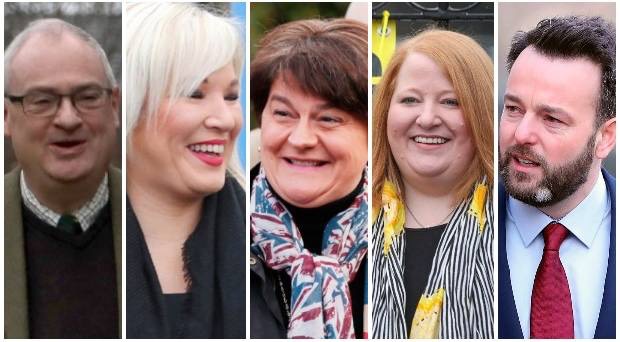
Turnout is high so far in the Westminster general election in both the north of Ireland and in Britain, where pollsters have been predicting a very slim Tory majority in the House of Commons or a hung parliament following today’s vote.
Irish Taoiseach Leo Varadkar has said he hopes the result will be “decisive” with a clear parliamentary majority for either Conservative leader Boris Johnson or for a coalition of parties in favour of holding a second Brexit referendum.
More than 600 polling stations across the North opened today at 7am and will close at 10pm. As is tradition, the northern party leaders (pictured) were among the first to vote (left to right: Steve Aiken (UUP), Michelle O‘Neill (SF), Arlene Foster (DUP), Naomi Long (Alliance), Colum Eastwood (SDLP)).
Turnout is noticeably higher in the more marginal constituencies - it was above 40% by 5pm in many areas of north Belfast, although other areas are closer to 30%, with a similar figure reported for many other constituencies.
At Stranmillis Evangelical Presbyterian Church, a controversial polling station in south Belfast, one box showed a turnout of 63% by 5pm, a possible record.
Nationalist hopes for a breakthrough fall on the shoulders of Sinn Fein’s John Finucane in north Belfast and the SDLP’s Claire Hanna in south Belfast, while the Alliance is in with a chance of defeating hardline unionists in both east Belfast and north Down.
Other closely watched candidates are Sinn Féin’s incumbent MP Michelle Gildernew in Fermanagh-South Tyrone and Danny Kinahan of the UUP in South Antrim, both of whom are in close contests against hardline pro-Brexit unionists where tactical voting could make a significant difference.
Former Sinn Féin leader Gerry Adams described today as “the peoples’ day -- the day you decide the shape and direction of politics for the next few years, and perhaps even longer.”
In an election day message, he noted that in the four elections since 2017, the unionist parties had lost their electoral majority.
“Last Friday evening unionists were back in the Ulster Hall for another of those rallies they periodically hold to save the union. ‘Rally for the Union,’ harked back to a similar meeting in 1912 when unionists met to oppose Home Rule,” he wrote.
“The Union flag was flown upside down – as it was in 1912 – because ‘Ulster is in distress.’ The rally was also a reminder of the DUP rally in 1986 at which the paramilitary self-styled Ulster Resistance was established. What do each of these, and many other similar rallies, have in common? An underlying deep seated distrust by unionists of British governments.
“Whatever the outcome of this British general election – whichever party or parties form the next government in London – or whoever wins the seats in the North - the unionist fear of and distrust in British governments will continue.”
He expressed the hope that in this election, those within unionism who “recognise the evil of Brexit” would be prepared to support those who oppose it.
“The DUP has rejected those who voted remain. They have rejected the northern electorate’s decision on Brexit. Instead they and others within loyalism who should know better, are playing on old sectarian fears.
“It’s time for change. It’s over to you the electorate. Use your vote wisely.”
You don’t require your poll card to vote but you do need photographic ID, which can include a British or Irish passport; a driving licence; a local bus pass or Smartpass; or an electoral identity card.
Any registered voter in the queue at a polling station by 10pm has the right to vote.
![[Irish Republican News]](https://republican-news.org/graphics/title_gifs/rn.gif)
![[Irish Republican News]](https://republican-news.org/graphics/title_gifs/harp.gif)

